LMD stands for Lambda Manipulating Device and comprises of three circuit variants as (based on their outward) is quite similarity. The circuit board dimensions are 58X36 mm for all. The three are: LMD PEX-TCE, LMD PEX-SL and LMD NEX. PEX and NEX is an abbreviation of Positive and Negative EXtension. PEX prolongs the positive voltage pulse response of the lambda probe (oxygen sensor) while the NEX prolongs the negative impulse response. Actually is the impulse response of a lambda probe always greater than zero and thus positive, but one can see the pulse change from 0.7 V to 0.2 V as a negative movement or flank. If one accept this view it is easier to categorize.
When one embarks to extend the lambda probe positive pulse simulates a fuel with high energy content and the ECU responds to reduce the supply of fuel. If the extension instead is related to the negative pulse simulated fuels with low energy content and the ECU increases the supply of fuel.
TCE may be represented by the wording: Temperature Control Enrichment - temperature controlled lambda control and with extra fuel enrichment. The positive extension is controlled by the engine temperature, unlike NEX that is not taking into account for the temperature.
TCE is intended for K220 (with an NTC resistor) and sensors that are compatible with K220.
NEX always prolongs the pulse a certain percentage as long as the power to the unit is on. SL is an abbreviation of ”slave”. So if one have multiple probes I guess everyone must be manipulated if one of them is manipulated. PEX-SL is thus a slave module or device which follows what the TCE doing.
The NEX-variant is used when one want the engine to get a snatch extra fuel, for example, to compensate the ethanol content in gasoline fuel - this provided that the vehicle is equipped with lamda-control. NEX can also be used for trimming.
Significantly more troublesome will it be to use a PEX-TCE.
A properly installed and adjusted PEX-TCE reduces the fuel consumption of vehicles powered by ethanol or E85!
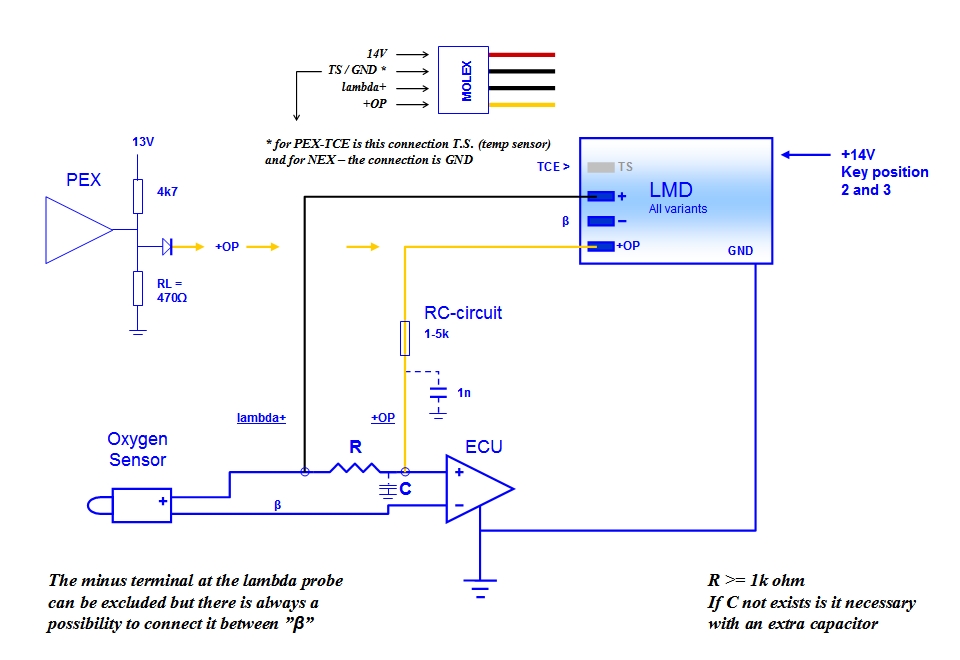
The figure above describes how one connects to the lambda probe for all LM-variants.
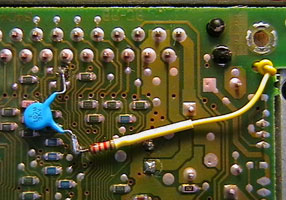 Wiring +OP with RC filters (Magneti Marelli)
Wiring +OP with RC filters (Magneti Marelli)
Before going into the details I must first explain the minimum requirements if one wish to connect and use an LMD.
- All variants are adapted for the feeding supply 12V. In fact it is 14V or 13.5-14.5V, to be able to face variations. It is important for the PEX'es to
gets there 14, while the NEX'es works over a wider voltage range.
- All variants must be connected to the lambda probe terminals and this is a bit special. The connection is made in two places; however the ground (minus
terminal) should not be connected. In the fuel computer as I usually say or the ECU/injection box must one search up the resistance the lambda signal passes
before it entering the operational amplifier OP or the comparator (a sort of OP). There are different systems but usually it exist at least one resistance.
PEX works if the resistance is higher or equal to 1000 ohms - is the resistance lower slips the manipulating signal back into the LMD and then there will be
feedback. The most common is that the resistance is around 100 kohms which is extremely beneficial for a PEX. The wire connection for lambda+ shall be
connected directly on the probe's positive terminal while the +OP-wire shall be connected after the resistor adjacent to the OP/comparator.
- If the resistance is high should one build an RC filter next to the OP/comparator so not the OP get broken. The input(s) to an OP must be protected by
at least one resistance around 1k.
- All variants have a red LED that flashes in rate with the lambda probe changes. The light strength follows the voltage fluctuations so that one can see
how quickly the probe is shifting. With the help of the LED have you in the bargain an opportunity to at any time study the function of a lambda probe, if
one obtains an LMD.
- Regarding PEX-TCE provides a temperature sensor that is equivalent to K220 sensors. This sensor is most common, powered by 5V, grounded into the body and
generates about 0.5 V when the engine has reached the operating temperature of 80 degrees Celsius. That restriction is only to be regretted and I am aware that
this kind of stuff really should be based on microprocessors, rather than analog technology - on the other hand have a modern motor controls, the ability to be
adjusted at the same way and the same results being achieved. But have the pull up resistor a different resistance than 2000 ohms so has it actually no
importance - it is just R10 and R11 which must be adjusted then, but the PEX does not affect. With a PEX-TCE obtains a balanced and stable remapping which
can be difficult to emulate if one intends to modify the software for an ECU. This can be quite cumbersome (and expensive), so not only the older fleet can
draw benefits from such a device.
PEX TCE requires two types of fuel additives before any consumption reduction can be observed. My understanding was that it is not about any fuel additive at all during testing, but where I mistook me dreadfully. The whole concept of electronic controls along with the alignment of the fuel chemical properties can be referred NAMAG+OC: Naphtha Alcohol Mix Adapted Glycol Oxygen Control. Fuel additives are AT2 and AG+. They can be used for all sorts of ethanol and gasoline constellations. Fuels intended for NAMAG+OC I call LFG fuels and from that angle is V-Power interesting. This gasoline contains namely similar naphtha resorts such as T66, which means that one can achieve a greater profit with a V-Power-based mixed fuel and based on this produce an LFG fuel.
We thus leave NEX and focuses on TCE from now on.
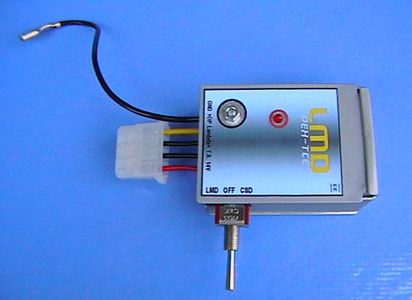
First, one can study the impact a PEX-TCE has on a typical converted gasoline engine with fuel injection.
Unfortunately, I have limited knowledge of other fuel control system than the one sitting in my car but I guess that the prospect that it also will work on other cars is promising, since my ECU is quite sensitive - even though I never got my engine warning light to illuminate how I may have varied the lambda probes parameters. I've tried with large extensions of the pulse both flanks and in that way got the car going extremely lean (or rich), I have studied the possible influence on the catalyst but have never been able to notice something extraordinary. The pulse lengths LMD work with are ridiculously short, when compared to my previous tests. The pulse extension must never cause interference (babble or jerking when accelerating) because then ruined all hopes of a possible improvement.
The engine must first get really hot before a manipulation can begin. The ECU will then not oppose because ethanol burns much more efficiently at high temperatures than at low. An ECU is mapped for gasoline and are totally unaware of this peculiarity ethanol possesses. Would one at let's say 75 (C) degrees start a manipulation must it be consistent, otherwise the ECU think that the fuel characteristics not can be predicted and it is more than a self-learning ECU can accept, which leading to brain hemorrhage. If the lambda becomes manipulated regularly so will the ECU conform this and decides that the fuel you now use is more energetic than normal E85. In reality, it is a electronic circuit that lean out, but with finesse. The PEX thus simulates a fuel with a high energy content which in reality actually is true. In addition to this, you have to manipulate soft. All changes on a lambda probes signal can not be done suddenly.
So - be consistent and regulate slow!
The result is that the vehicle can feel weaker when the manipulation entry into force (ie the same conditions as in gasoline mode) and that the fuel consumption had been reduced. After driving the vehicle with a PEX will one notice that it appeared to be completely optimized for E85 - everything is better than a simple conversion can achieve.
In its default version is a PEX-TCE equipped with the module UCS. It can be found on the underside of a PEX board. UCSM is basically a CSD but with some differences that's have to do with integration. One can with a 3-way switch choose whether one wants to run PEX-TCE with UCSM (default mode) or just UCSM. In the center position is the device off. If one chooses merely UCSM is it all the same as a CSD! Choke, enrichment and lambda manipulation is not necessary if one wishes to run on gasoline and for that reason; one can move the switch to the center position.
In order to be able to size R10 and R11 regarding UCSM so must one know the pull up resistor for your particular vehicle. Although the voltage when the enrichment shall expire may be good to check. Please test the measured values in this excel program.
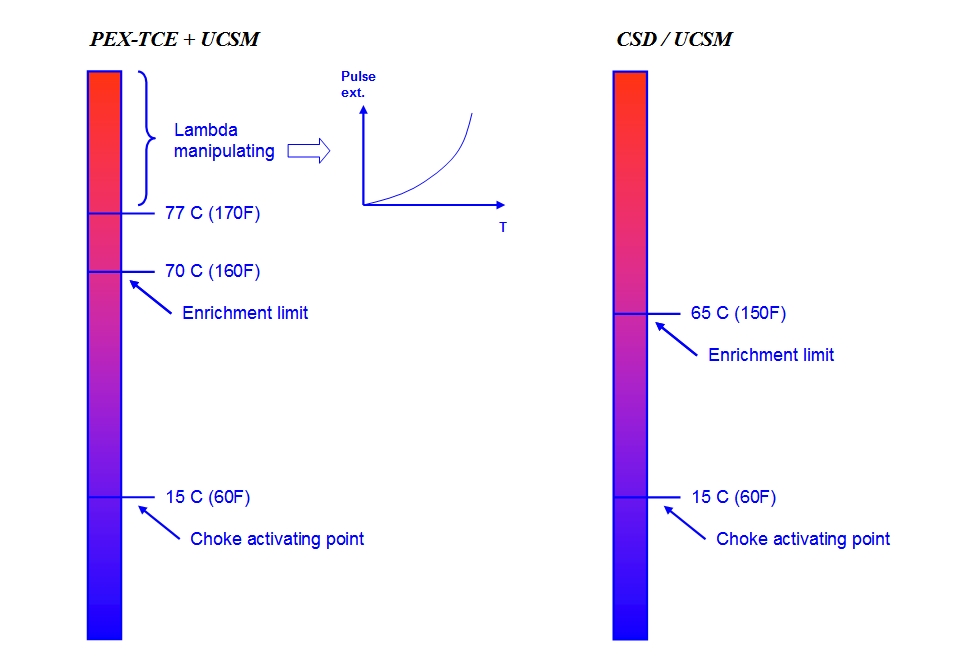
Now I can not speak for all concerned, but when it comes to my car along with a PEX so it is important to set the correct amount of fuel. Referred the pulse extension associated to the fuel injectors (not the lambda probe).
Thus, at PEX-operation should the piggy back pulse extension be adjusted precisely, ie a slightly lean setting!
This particular condition is not a problem for me to meet because I can turn the potentiometer after the LEDs on my RCW panel so that the fuel supply is consistent corresponding with gasoline. Some leeway can be accepted by a PEX, but it's not about any major deviations - suddenly increased the demands for a piggy back huge... It is with the use of a PEX as the impact of a fuel additive causes a major impact on the vehicle. Still no problem - because if you fill the tank in the same way each time you not need to do anything, but if you change your routines and refrain an opening time-reducing fuel additive - then must the pulse extension be readjusted. Even the weather, ie outside temperature affects the fuel's opening time-reduction - another factor to consider. Is the extension misconfigured so will the vehicle however react by responding poorly to the throttle, the symptoms teaches thus prove themselves which is just fine.
UCSM delivers both choke and enrichment and nothing else. When running TCE is it always an ”extra enrichment” that will be added, as far one not disconnect UCSM.
When you has taken the described adjustment measure and put down your piggy back (in order to benefit lambda manipulation), it entails that the enrichment (and the choke) is slightly low pledged also because the engine behaves differently when it is cold and want the same amount of fuel as it always have had - even though the pulse extension seems off when the operating temperature has been reached. This is what the extra enrichment is for: It automatically adds to it that disappeared when your piggy back was stingy - and nothing else.
Difference will it be if you only use CSD or UCSM - because then usually most piggy backs need to be turned up a little bit more than necessary. At this upward adjustment should one switch off the extra enrichment and that is exactly what happens when one shifts the switch to only CSD operation.
The picture and the description below are useful when you want/need to change anything. These could be about to move the temperature where the lambda manipulation will start, or how strong manipulation you want (via Pe). Although the enrichment stop temperature may sometimes be necessary to amend.
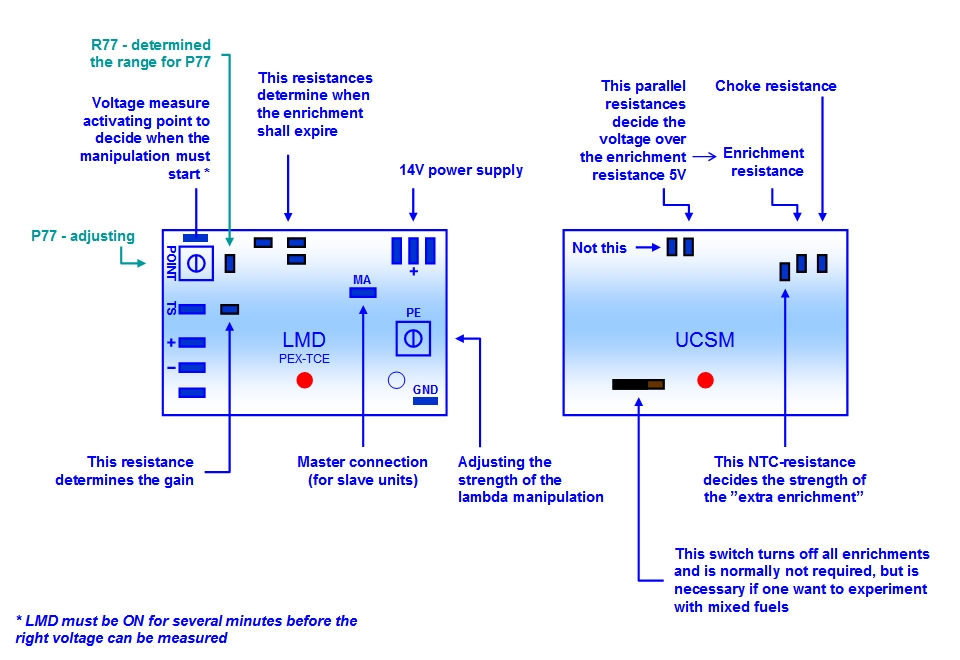
The way how to proceed in order to make it all to work can be divided into four scenarios. One can assume that the PEX is installed and the piggy back doing their job.
Case one, you choosing to use only E85:
- The rate of the lambda manipulation is tested or Pe is set in the middle position.
- The fuel additives AT2 and AG+ shall be used.
Case three, you decide to use mixed fuels:
- The lambda manipulation strength should be reduced if the ethanol content is less than 75%.
- The piggy back pulse extension need to be adjusted.
- The fuel additives AT2 and AG+ shall be used.
Case four, one is from the outset only interested in mixed fuels then: Do NOT order a PEX with UCSM. You will then only get a TCE but the board is prepared to be extended if one in the future repents itself.
In addition to this fuel-saving effect can one experience several synergies with a PEX.
- When the fuel quantity is reduced (at normal engine temperature) accelerates the temperature. PEX stimulating lean operation and thus fueling a rise in
temperature, which is advantageous for ethanol.
- The temperature of the fuel does not seem to have any relevance here. Tests have been done in the winter cold below freezing and everything indicated
that it actually works better in the winter, for some reason. What I am referring to is therefore the lower fuel consumption.
- The more opening time-reducing a fuel additive is the more should the fuel consumption decreases.
Why it is doing so well in winter conditions is still not fully understood, but to use devices for preheating the fuel/air seems almost unnecessary. However, you should clog the radiator air intake as much as possible. The faster the engine temperature rise and the higher the temperature is, the more will the PEX add positive pulse into the lambda probe. I use insulation and tape which clogs the air vents and reduces the car's aerodynamic drag.
Will the outdoor temperature get too low should not this working however. PEX-TCE is not tested 20 degrees Celsius below zero and therefore can I not guarantee any use of this device - in such circumstances.
When it comes to the fuel consumption savings, one can expect a 5 percent improvement or thereabouts. It is difficult to measure the consumption because the profit is greatest when lambda is working. So it is when lying and rub on a motorway/highway (or avoid driving too varied) that the results turn out, which actually happens more often than one think. I have for that reason been unable to obtain any sensible numbers on my ”measure car”, but I have listed fuel consumption reduction of the measure car many times. An essential factor to improve the numbers is that everything really is correctly set and just this probably was not my measure car when the project was in the development phase. Nowadays should several pieces be in place. As I like to say - I've driven hundreds of mils...
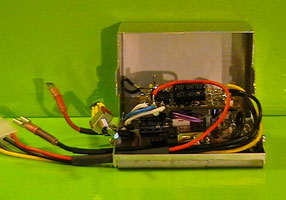
If you want to look closer on this thing you can download it here:
In the zip-file can you find everything required to implement it (manuals, diagrams and PCB-files)
- except to realizing it.
| LMD#A-2 |
# A-1 Is the first audit.
# A-2 If it is difficult to find the resistance required for a PEX, is now the module O2SIM available. It is a buffer amplifier whose output mimics a lambda probe, which at the same time (without being noticed) is manipulated.

